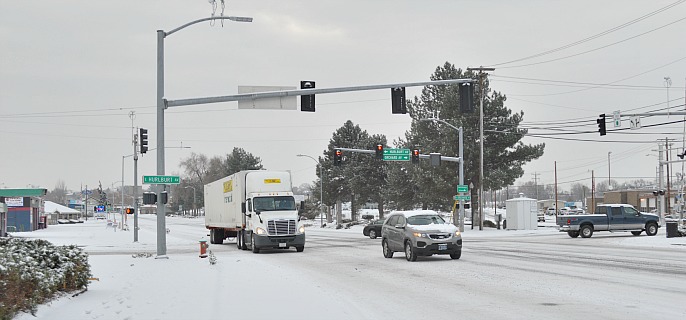It doesn’t take much snow to turn the roads slick and icy. With more snow falling today and additional snow forecast for the week, AAA has some tips for driving in the snow:
• Accelerate and decelerate slowly. Applying the gas slowly to accelerate is the best method for regaining traction and avoiding skids. Don’t try to get moving in a hurry. And take time to slow down for a stoplight. Remember: It takes longer to slow down on icy roads.
• Drive slowly. Everything takes longer on snow-covered roads. Accelerating, stopping, turning – nothing happens as quickly as on dry pavement. Give yourself time to maneuver by driving slowly.
• The normal dry pavement following distance of three to four seconds should be increased to eight to ten seconds. This increased margin of safety will provide the longer distance needed if you have to stop.
• Know your brakes. If you have anti-lock brakes (ABS) and need to slow down quickly, press hard on the pedal-it’s normal for the pedal to vibrate a bit when the ABS is activated.
• Don’t stop if you can avoid it. There’s a big difference in the amount of inertia it takes to start moving from a full stop versus how much it takes to get moving while still rolling. If you can slow down enough to keep rolling until a traffic light changes, do it.
• Don’t power up hills. Applying extra gas on snow-covered roads just starts your wheels spinning. Try to get a little inertia going before you reach the hill and let that inertia carry you to the top. As you reach the crest of the hill, reduce your speed and proceed downhill as slowly as possible.
• Don’t stop going up a hill. There’s nothing worse than trying to get moving up a hill on an icy road. Get some inertia going on a flat roadway before you take on the hill.
• Stay home. If you really don’t have to go out, don’t. Even if you can drive well in the snow, not everyone else can. Don’t tempt fate: If you don’t have somewhere you have to be, watch the snow from indoors.
IF YOU’RE STUCK
• Clear a path in front of your wheels for several feet by driving forward and backward or shoveling.
• With your wheels pointed straight to minimize rolling resistance, shift to “drive” (or second gear for manual transmissions) and apply gentle pressure to the accelerator, WITHOUT spinning the wheels. If you let the wheels spin, you will only dig deeper into the snow.
• If you need more traction, use traction mats, kitty litter, or one of the abrasive materials that you included in your emergency winter driving kit. Do not let anyone stand directly ahead or behind the drive wheels.
• If you are still stuck, rock your vehicle out of the rut by applying the accelerator slowly in low gear, releasing when you stop moving forward, and re-applying when you stop rolling backward. Repeat in rapid succession using minimum power to avoid spinning wheels.










